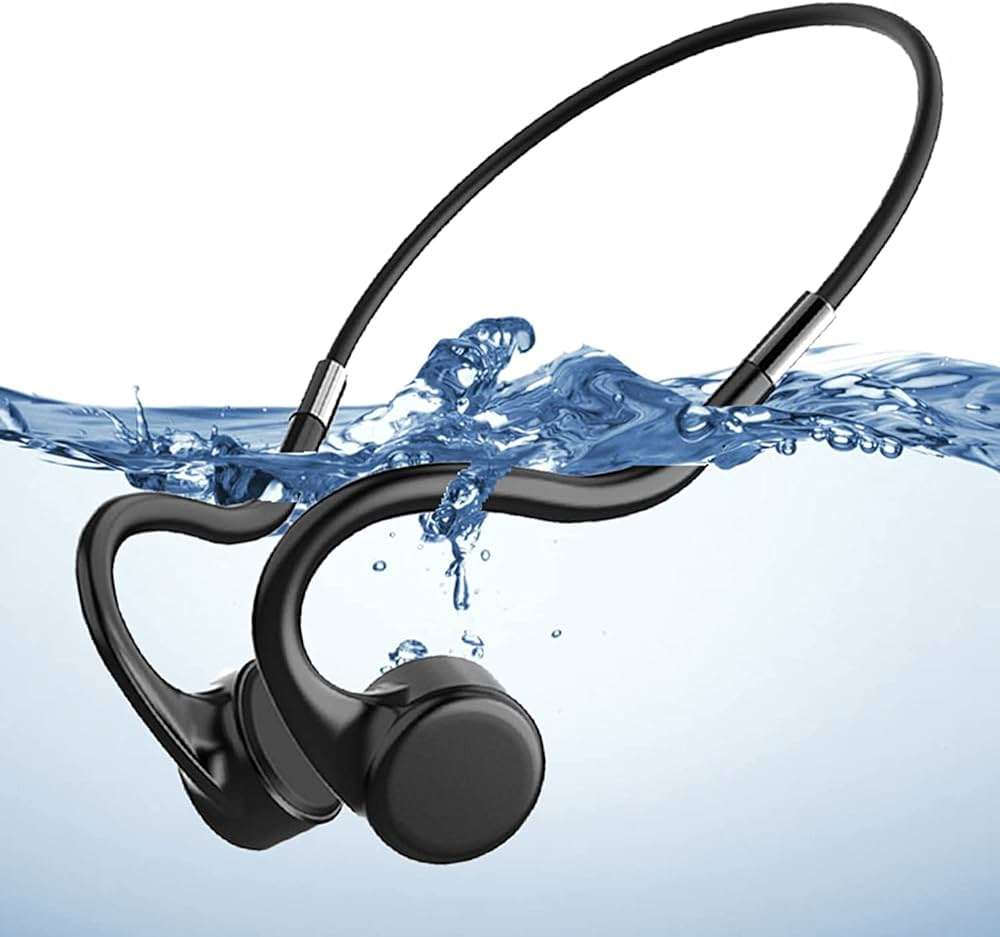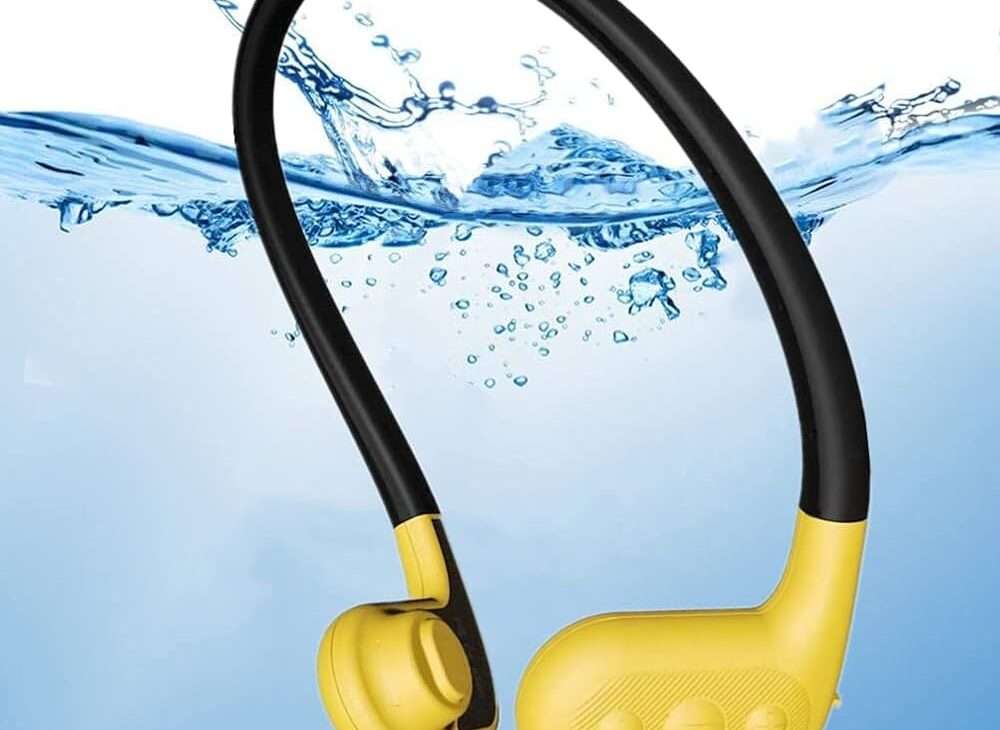Bone conduction headphones for swimming transmit audio through the cheekbones. They provide a safe listening experience by keeping the ears unblocked.
These specialized headphones have revolutionized aquatic listening, allowing swimmers to enjoy music or audiobooks while underwater.
Waterproof and designed to withstand submersion, bone conduction headphones are perfect for swimmers who crave an audio companion without compromising ear health.
They feature a design that repels water, preventing damage and ensuring clear sound quality. By utilizing vibrations, they bypass the eardrum, delivering sound directly to the inner ear, which is a boon for those with hearing impairments or ear infections.
Embracing this advanced audio technology helps enhance swim workouts, making laps less monotonous and swimming sessions more enjoyable.
Taking The Plunge With Technology
Imagine diving into crystal-clear waters with your favorite tunes as your underwater soundtrack. The advanced world of bone conduction headphones now makes this possible.
Swimmers around the globe embrace this groundbreaking technology, elevating their aquatic experience to a whole new level.
Bone Conduction Basics
Unlike traditional headphones, bone conduction headphones transmit sound through vibrations. These vibrations travel through the cheekbones directly to the inner ear. This means your ears remain open to natural sound, adding a layer of safety for swimmers.
- Leaves ears open to ambient noise
- Uses cheekbones to transmit sound
- Waterproof designs for swimmers
Swimming With Sound
Whether you’re a professional swimmer or enjoy a casual dip, bone conduction headphones can enhance your water sessions. Waterproof and secure, they stay on during vigorous activity, delivering clear audio beneath the waves.
| Feature | Benefit |
|---|---|
| Waterproof design | No damage underwater |
| Secure fit | Stays put during laps |
| Clear sound quality | Enjoy music while swimming |
History Of Bone Conduction
Let’s dive into the History of Bone Conduction and discover how it evolved into an underwater audio marvel. Bone conduction isn’t new; it’s a tech with deep roots. For swimming enthusiasts, it has morphed into a safe way to enjoy music without blocking the ears.
Early Discoveries
The concept dates back to none other than Ludwig van Beethoven. The famous composer, losing his hearing, found a quirky way to sense sound. He bit down on a rod attached to his piano.
This way, the music vibrations traveled through his jawbone right to his inner ear. Beethoven effectively used bone conduction before it even had a name.
- Beethoven: Used a rod to hear piano notes.
- Giulio Cesare Tagliacozzi: Noticed skull vibrations transmit sound.
- Military Tech: Applied bone conduction for communication.
Evolving Audio Tech
The military saw potential in bone conduction. Soldiers used it to communicate quietly and hands-free. Eventually, this tech reached the public sector. By the 21st century, companies started creating bone conduction devices for daily use.
These devices don’t just pass sound through the air. They vibrate against your cheekbones to send audio straight to the inner ear.
| Year | Development |
|---|---|
| Early 2000s | First consumer headsets appeared. |
| 2010s | Refinement and wide adoption. |
| 2020s | Waterproof models for swimming. |
Today, bone conduction headphones for swimming are sleek, waterproof, and efficient. They let you groove to your favorite tunes underwater without traditional earbuds. Bone conduction has evolved significantly, from Beethoven’s improvisations to today’s modern aquatic audio gear.
Design And Durability
Swimmers, get ready for an underwater music experience like no other with bone conduction headphones. Durable design meets innovative technology to keep your tunes flowing, even when you’re doing laps.
Let’s dive into what makes them a swimmer’s best friend.
Waterproof Features
When selecting headphones for swimming, waterproof capabilities top the list.
- IPX rating: Look for a high IPX rating, which means your device can withstand prolonged submersion.
- Sealing: Quality gaskets seal out water, protecting delicate electronics inside.
- Wet functionality: Controls work smoothly, even when wet.
Material And Build
The materials and construction of bone conduction headphones are crucial.
They must endure chlorine and saltwater without damage.
| Material | Properties |
|---|---|
| Frames | Flexible, non-corrosive, and lightweight for comfort and longevity. |
| Pads | Hypoallergenic and gentle on the skin to prevent irritation. |
| Electronics | Corrosion-resistant and securely enclosed to avoid water damage. |
The Science Of Sound Underwater
Swimmers often struggle to enjoy music due to the water’s challenging acoustics. Understanding how sound behaves in water is essential to appreciate the technology behind bone conduction headphones designed for swimming.
Sound Transmission In Water
Unlike air, water is a denser medium for sound waves to travel through. This density allows sound to move faster underwater, yet our ears are not designed to capture these waves directly in water.
Bone conduction headphones bypass this limitation by directly transmitting vibrations to the inner ear through the bones, making the sound clear and discernible even while submerged.
- Sound travels around four times faster in water than in air.
- Underwater, traditional air-conduction headphones lose their efficiency.
- Vibration paths through bones bypass the outer ear entirely.
Advantages Of Bone Conduction
Bone conduction technology offers a unique set of advantages:
| Advantage | Description |
|---|---|
| Clear Sound Underwater | Direct transmission ensures music and audio are uninterrupted and clear. |
| Ear Protection | External ear remains unblocked, reducing the risk of ear infections. |
| Awareness | Maintains ambient sound awareness for safer swimming experiences. |
Bone conduction headphones allow swimmers to enjoy their favorite tracks without sacrificing comfort or sound clarity. Ideal for aquatic environments, these headphones are a game-changer in underwater audio.
Comparing Bone Conduction And Traditional Earphones
When entering the world of underwater audio, choosing the right type of headphones is pivotal. Water enthusiasts often find themselves weighing bone conduction headphones against traditional earphones.
Each offers a unique listening experience. Below we dive into the key differences, focusing on safety considerations and sound quality differences.
Safety Considerations
Bone conduction headphones stand out for safety. They rest on your temples, not in your ears. This design lets you hear your surroundings. You stay alert in the water, hearing coaches, lifeguards, or potential hazards.
Traditional earphones block your ears, isolating you from the environment. This isolation can pose risks during swimming or other water activities.
Sound Quality Differences
Sound quality underwater is a challenge for any audio device. Bone conduction headphones bypass ear canal issues, sending sound vibrations through your cheekbones. This method works well in water but might sound less crisp compared to air use.
In contrast, traditional earphones offer high sound quality on land but often have trouble delivering that same clarity underwater. Water pressure and poor earbud sealing can distort sound, reducing your listening experience.
- Bone conduction:
- Good for underwater hearing
- Less crisp than air
- Traditional earphones:
- The high sound quality on land
- Poor underwater performance

Credit: www.temu.com
Choosing The Right Pair
Are you a swimmer searching for headphones that stay put during your laps? Bone conduction headphones are the answer. They allow you to hear your favorite tunes and stay aware of your surroundings. But picking the right pair is crucial.
Let’s dive into the details to help you find your underwater music companion.
Critical Specs For Swimmers
Not every bone conduction headphone can handle the pool’s challenges. Focus on these specs:
- Waterproof Rating: Look for an IPX rating of 8 or higher. This means they can safely submerge in water.
- Comfort: Choose lightweight designs. They should not cause any discomfort during extended swims.
- Secure Fit: Opt for models that include a band or clip. These features prevent your headphones from slipping off.
- Battery Life: Ensure they last through long sessions. A battery life of 6 hours or more is ideal.
- Sound Quality: Good bone conduction technology is a must. It ensures clear audio beneath the surface.
Top Brands On The Market
Some brands stand out in the aquatic audio game. Let’s look at a few top players:
| Brand | Model | Waterproof Rating | Battery Life |
|---|---|---|---|
| Aftershokz | Xtrainerz | IP68 | 8 hours |
| Finis | Duo | IPX8 | 7 hours |
| Tayogo | Waterproof MP3 Player | IPX8 | 6 hours |
Each brand brings unique features. Aftershokz stands out for comfort. Finis focuses on sound quality. Tayogo offers integrated MP3 storage.
Setting Up For A Swim
Bone conduction headphones for swimmers are ideal who love to groove to music while slicing through the water. Setting up for a swim with these headphones can enhance your experience.
Pairing with your device and adjusting for the perfect fit requires just a few simple steps. Enjoy your aquatic adventures with music by your side without worrying about water damage.
Pairing With Devices
Connecting your headphones to your music device is the first step before diving in. Here’s an easy guide:
- Turn on your bone conduction headphones.
- Enable Bluetooth on your swimming MP3 player or smart device.
- Select your headphones from the list of available devices.
- Confirm the pairing and start your playlist.
Make sure your music device is waterproof or placed in a waterproof case if needed.
Optimizing The Fit
A secure and comfortable fit is crucial for uninterrupted music while swimming. Follow these tips:
- Adjust the band to prevent the headphones from shifting.
- Test the fit on land before entering the water.
- Wear a swim cap over the headphones if necessary for extra stability.
Proper fit ensures you hear your music clearly under the waves.

Credit: www.walmart.com
Caring For Your Headphones
Bone conduction headphones have changed the way we swim with music. These innovative devices require proper care to maintain their performance. Learn to keep your underwater soundtrack as fresh as your swim stroke with these easy-care tips!
Maintenance Tips
Keep your bone conduction headphones in top shape with these helpful strategies:
- Rinse them with fresh water after each swim.
- Ensure they are dry before charging.
- Inspect for sand or debris and gently clean as necessary.
- Use the correct charging cable to prevent damage.
- Avoid exposure to extreme temperatures or conditions.
Storage Solutions
Where you keep your headphones can be as important as how you maintain them. Follow these storage tips:
- Store in a cool, dry place when not in use.
- Use a protective case to avoid physical damage.
- Avoid tight spaces where the headphones can be crushed.
- Keep away from sharp objects that might scratch the headphones.
| Do’s | Don’ts |
|---|---|
| Keep in a case | Expose to sun |
| Dry thoroughly | Charge when wet |
| Clean regularly | Store with heavy items |
Beyond The Pool
Think bone conduction headphones are just for swimming? No way! These nifty gadgets shine both in and out of the water. They ensure you enjoy music without blocking your ears.
Let’s dive into the world beyond the pool and see how these headphones rock your cross-training workouts and daily routines.
Cross-training Usage
Bone conduction headphones are perfect for cross-training. Strong grip and water-resistant features mean you can switch from swimming to land workouts smoothly.
- Running: Stay aware of your surroundings with open ears.
- Biking: Listen to music and hear traffic. Safety first!
- Gym Workouts: Enjoy tunes without missing trainer calls.
Everyday Life Applications
Bone conduction headphones transition seamlessly into everyday life. Stay connected with music, calls, and the environment around you.
| Activity | Benefit |
|---|---|
| Commuting | Hear announcements while enjoying podcasts. |
| Working | Take calls without missing office buzz. |
| Home Chores | Rock out to music and hear the doorbell. |

Credit: www.amazon.com
User Experiences And Testimonials
Swimmers across the board are diving into a new audio experience with bone conduction headphones. Enthusiasts rave about their underwater music sessions. Let’s dive into what users say about their audio companions during their swim.
Professional Swimmer Insights
Competitive swimmers highlight the edge these headphones give. Elite swimmers train for hours. They rely on music to stay in rhythm. Their feedback points out how these headphones fit snugly. They do not slip during vigorous laps.
Also, the sound quality stays consistent underwater. It is not just about enjoyment. It is also about performance.
- The better focus during training
- No interruption due to slipping
- Clear sound underwater
Casual User Reviews
Recreational swimmers love these headphones as well. They share stories of relaxed swim sessions. Music becomes a part of their leisure time. Many note the safety these headphones offer. They can hear the environment around them. This is due to the open-ear design. They feel more aware and at ease.
Here is what some casual swimmers say:
| User | Experience |
|---|---|
| Sam | Loves the seamless blend of music and water. |
| Alex | Feels safe, thanks to being aware of surroundings. |
| Julie | Adores the comfort and secure fit during leisure laps. |
The Future Of Aquatic Audio
The Future of Aquatic Audio no longer rests on the edge of the pool. Bone conduction headphones for swimming have surfaced, allowing swimmers to enjoy music underwater.
Welcoming a new tide of wearable technology, these devices offer an immersive experience without blocking the ear canal. Swimming enthusiasts can now dive into an ocean of songs and podcasts, transforming every stroke into a rhythm.
Emerging Technologies
Bone conduction headphones utilize vibrations to transmit sound directly to the inner ear. This technology is making waves with swimmers for several reasons:
- Safety: Keeps ears open to environmental sounds.
- Comfort: Eliminates the discomfort of traditional earbuds.
- Durability: Water-resistant materials protect against chlorine and saltwater.
Integrating wireless connectivity and touch controls means swimmers can adjust settings without interrupting their flow.
Innovations To Watch
Innovations in aquatic audio are pushing boundaries. What’s coming next is exciting:
| Feature | Benefit |
|---|---|
| MP3 Storage | Store songs directly on the device. |
| Longer Battery Life | Swim longer without worrying about recharging. |
| Smart Assistant Integration | Control music with voice commands underwater. |
Manufacturers are also exploring improvements in sound quality and noise cancellation. Expect to see more designs catering to competitive and casual swimmers alike.
Frequently Asked Questions For Bone Conduction Headphones For Swimming
Are Bone Conduction Headphones Good For Swimming?
Bone conduction headphones for swimming are excellent because they provide clear audio without blocking ear canals. This allows swimmers to stay aware of their surroundings. They use vibrations to transmit sound, bypassing water interference, and making them suitable for indoor and outdoor swimming pools.
What’s The Battery Life Of Swimming Headphones?
The battery life for swimming bone conduction headphones typically ranges from 4 to 8 hours on a single charge. This duration depends on the model and manufacturer, and some offer quick charging for shorter top-up times. Always check the specs before purchasing.
How Do Bone Conduction Headphones Fit While Swimming?
Bone conduction headphones are designed to wrap around the head and rest on the cheekbones securely. This ensures a comfortable, stable fit during vigorous swimming motions. They often come with a band that keeps them tight against your head to avoid slipping off while swimming.
Can You Wear Bone Conduction Headphones Under A Swim Cap?
Yes, bone conduction headphones can be worn under a swim cap. Most models are slim and can comfortably fit without adding bulk, enhancing stability and ensuring their proper function without impairing your swimming efficiency.
Conclusion
Diving into aquatic adventures with the right gear makes all the difference. Bone conduction headphones offer swimmers a blend of sound quality and underwater functionality. These devices enhance the swim experience and ensure safety by maintaining ambient awareness.
Embrace this innovative technology and elevate your swim sessions to rhythmic perfection.

A passionate tech blogger and the founder of Best Tech View, a dynamic platform dedicated to all things technology. With a keen interest in the tech, Ahmad strives to provide insightful and engaging content on the latest tech trends, and breakthroughs.




